Effects of Gurney Flaps on the Performance of a Horizontal Axis Ocean Current Turbine
Abstract
:1. Introduction
- The effect of Gurney flap height on the hydrodynamic characteristics of the airfoil at different angles of approach.
- The relationship between the dynamic performance of the airfoil and the Gurney flap height.
- The effect of different radial lengths of Gurney flaps on the hydrodynamic performance of the airfoil.
2. Geometric Description
2.1. HAOCT Rotor Model
2.2. Gurney Flaps
2.3. Coefficients for Performance
3. Numerical Method
3.1. Computation Domain and Boundary Conditions
3.2. Mesh Generation
3.3. Solution Settings and Validation of Numerical Methods
4. Results and Discussion
4.1. Hydrodynamic Performance of Gurney Flaps Height
4.2. Effect of the Full-Length Gurney Flap on Turbine
4.3. Hydrodynamic Performance of Gurney Flaps Radial Dimensions
5. Conclusions
Author Contributions
Funding
Institutional Review Board Statement
Informed Consent Statement
Data Availability Statement
Conflicts of Interest
Nomenclature
| Tip speed ratio | |
| Number of blades | |
| Rotor rotation speed [rad/s] | |
| Angles of attack [°] | |
| U | Free-stream velocity [m/s] |
| U’ | Local stream velocity [m/s] |
| Turbulence intensity [%] | |
| Rotor radius [m] | |
| Rotor diameter [m] | |
| Hub length [m] | |
| Hub radius [m] | |
| Flap length [m] | |
| Flap height [m] | |
| Local radius [m] | |
| Local chord length [m] | |
| Power coefficient | |
| Thrust coefficient |
References
- Li, M.; Luo, H.; Zhou, S.; Senthil Kumar, G.M.; Guo, X.; Law, T.C.; Cao, S. State-of-the-Art Review of the Flexibility and Feasibility of Emerging Offshore and Coastal Ocean Energy Technologies in East and Southeast Asia. Renew. Sustain. Energy Rev. 2022, 162, 112404. [Google Scholar] [CrossRef]
- Khan, M.Z.A.; Khan, H.A.; Aziz, M. Harvesting Energy from Ocean: Technologies and Perspectives. Energies 2022, 15, 3456. [Google Scholar] [CrossRef]
- Bhuiyan, M.A.; Hu, P.; Khare, V.; Hamaguchi, Y.; Thakur, B.K.; Rahman, M.K. Economic Feasibility of Marine Renewable Energy: Review. Front. Mar. Sci. 2022, 9, 988513. [Google Scholar] [CrossRef]
- Rehman, S.; Alhems, L.M.; Alam, M.M.; Wang, L.; Toor, Z. A Review of Energy Extraction from Wind and Ocean: Technologies, Merits, Efficiencies, and Cost. Ocean Eng. 2023, 267, 113192. [Google Scholar] [CrossRef]
- Zhang, J.; Liu, S.; Guo, Y.; Sun, K.; Guan, D. Performance of a Bidirectional Horizontal-Axis Tidal Turbine with Passive Flow Control Devices. Renew. Energy 2022, 194, 997–1008. [Google Scholar] [CrossRef]
- Satrio, D.; Suntoyo; Ramadhan, L.I. The Advantage of Flow Disturbance for Vertical-Axis Turbine in Low Current Velocity. Sustain. Energy Technol. Assess. 2022, 49, 101692. [Google Scholar] [CrossRef]
- Yang, M.-H.; Gu, Z.-T.; Yeh, R.-H. Numerical and Experimental Analyses of the Performance of a Vertical Axis Turbine with Controllable-Blades for Ocean Current Energy. Energy Convers. Manag. 2023, 285, 117009. [Google Scholar] [CrossRef]
- Tigabu, M.T.; Khalid, M.S.U.; Wood, D.; Admasu, B.T. Some Effects of Turbine Inertia on the Starting Performance of Vertical-Axis Hydrokinetic Turbine. Ocean Eng. 2022, 252, 111143. [Google Scholar] [CrossRef]
- Nachtane, M.; Tarfaoui, M.; Goda, I.; Rouway, M. A Review on the Technologies, Design Considerations and Numerical Models of Tidal Current Turbines. Renew. Energy 2020, 157, 1274–1288. [Google Scholar] [CrossRef]
- Kundu, P.; Sarkar, A.; Nagarajan, V. Improvement of Performance of S1210 Hydrofoil with Vortex Generators and Modified Trailing Edge. Renew. Energy 2019, 142, 643–657. [Google Scholar] [CrossRef]
- Fan, M.; Sun, Z.; Yu, R.; Dong, X.; Li, Z.; Bai, Y. Effect of Leading-Edge Tubercles on the Hydrodynamic Characteristics and Wake Development of Tidal Turbines. J. Fluids Struct. 2023, 119, 103873. [Google Scholar] [CrossRef]
- Mansi, A.; Aydin, D. The Impact of Trailing Edge Flap on the Aerodynamic Performance of Small-Scale Horizontal Axis Wind Turbine. Energy Convers. Manag. 2022, 256, 115396. [Google Scholar] [CrossRef]
- Nanda, S.; Ahmed, S.; Warudkar, V.; Gautam, A. Effect of Uniformly Varying Width Leading-Edge Slots on the Aerodynamic Performance of Wind Turbine Blade. Mater. Today Proc. 2023, 78, 120–127. [Google Scholar] [CrossRef]
- Barbarić, M.; Batistić, I.; Guzović, Z. Numerical Study of the Flow Field around Hydrokinetic Turbines with Winglets on the Blades. Renew. Energy 2022, 192, 692–704. [Google Scholar] [CrossRef]
- Wang, J.J.; Li, Y.C.; Choi, K.-S. Gurney Flap—Lift Enhancement, Mechanisms and Applications. Prog. Aerosp. Sci. 2008, 44, 22–47. [Google Scholar] [CrossRef]
- Basso, M.; Cravero, C.; Marsano, D. Aerodynamic Effect of the Gurney Flap on the Front Wing of a F1 Car and Flow Interactions with Car Components. Energies 2021, 14, 2059. [Google Scholar] [CrossRef]
- Genest, B.; Dumas, G. Numerical Investigation into Single and Double Gurney Flaps for Improving Airfoil Performance. J. Aircr. 2023, 1–15. [Google Scholar] [CrossRef]
- Fatahian, H.; Salarian, H.; Eshagh Nimvari, M.; Khaleghinia, J. Effect of Gurney Flap on Flow Separation and Aerodynamic Performance of an Airfoil under Rain and Icing Conditions. Acta Mech. Sin. 2020, 36, 659–677. [Google Scholar] [CrossRef]
- Bianchini, A.; Balduzzi, F.; Di Rosa, D.; Ferrara, G. On the Use of Gurney Flaps for the Aerodynamic Performance Augmentation of Darrieus Wind Turbines. Energy Convers. Manag. 2019, 184, 402–415. [Google Scholar] [CrossRef]
- Ye, X.; Hu, J.; Zheng, N.; Li, C. Numerical Study on Aerodynamic Performance and Noise of Wind Turbine Airfoils with Serrated Gurney Flap. Energy 2023, 262, 125574. [Google Scholar] [CrossRef]
- Syawitri, T.P.; Yao, Y.-F.; Yao, J.; Chandra, B. The Effect of Gurney Flap on Flow Characteristics of Vertical Axis Wind Turbine. Int. J. Mod. Phys. B 2020, 34, 2040107. [Google Scholar] [CrossRef]
- Syawitri, T.P.; Yao, Y.; Yao, J.; Chandra, B. Geometry Optimisation of Vertical Axis Wind Turbine with Gurney Flap for Performance Enhancement at Low, Medium and High Ranges of Tip Speed Ratios. Sustain. Energy Technol. Assess. 2022, 49, 101779. [Google Scholar] [CrossRef]
- Zhang, Y.; Ramdoss, V.; Saleem, Z.; Wang, X.; Schepers, G.; Ferreira, C. Effects of Root Gurney Flaps on the Aerodynamic Performance of a Horizontal Axis Wind Turbine. Energy 2019, 187, 115955. [Google Scholar] [CrossRef]
- Zhu, H.; Hao, W.; Li, C.; Ding, Q. Numerical Study of Effect of Solidity on Vertical Axis Wind Turbine with Gurney Flap. J. Wind Eng. Ind. Aerodyn. 2019, 186, 17–31. [Google Scholar] [CrossRef]
- Kumar, P.M.; Samad, A. Introducing Gurney Flap to Wells Turbine Blade and Performance Analysis with OpenFOAM. Ocean Eng. 2019, 187, 106212. [Google Scholar] [CrossRef]
- Bahaj, A.S.; Molland, A.F.; Chaplin, J.R.; Batten, W.M.J. Power and Thrust Measurements of Marine Current Turbines under Various Hydrodynamic Flow Conditions in a Cavitation Tunnel and a Towing Tank. Renew. Energy 2007, 32, 407–426. [Google Scholar] [CrossRef]
- Batten, W.M.J.; Bahaj, A.S.; Molland, A.F.; Chaplin, J.R. Experimentally Validated Numerical Method for the Hydrodynamic Design of Horizontal Axis Tidal Turbines. Ocean Eng. 2007, 34, 1013–1020. [Google Scholar] [CrossRef]
- Chandrasekhara, M.S. Optimum Gurney Flap Height Determination for “Lost-Lift” Recovery in Compressible Dynamic Stall Control. Aerosp. Sci. Technol. 2010, 14, 551–556. [Google Scholar] [CrossRef]
- Molland, A.F.; Bahaj, A.S.; Chaplin, J.R.; Batten, W.M.J. Measurements and Predictions of Forces, Pressures and Cavitation on 2-D Sections Suitable for Marine Current Turbines. Proc. Inst. Mech. Eng. Part M J. Eng. Marit. Environ. 2004, 218, 127–138. [Google Scholar] [CrossRef]
- He, X.; Wang, J.; Yang, M.; Ma, D.; Yan, C.; Liu, P. Numerical Simulation of Gurney Flap on SFYT15thick Airfoil. Theor. Appl. Mech. Lett. 2016, 6, 286–292. [Google Scholar] [CrossRef]
- Bak, C.; Fuglsang, P.; Johansen, J.; Antoniou, I. Wind Tunnel Tests of the NACA 63-415 and a Modified NACA 63-415 Airfoil; Risoe National Lab.: Roskilde, Denmark, 2000; 107p. [Google Scholar]

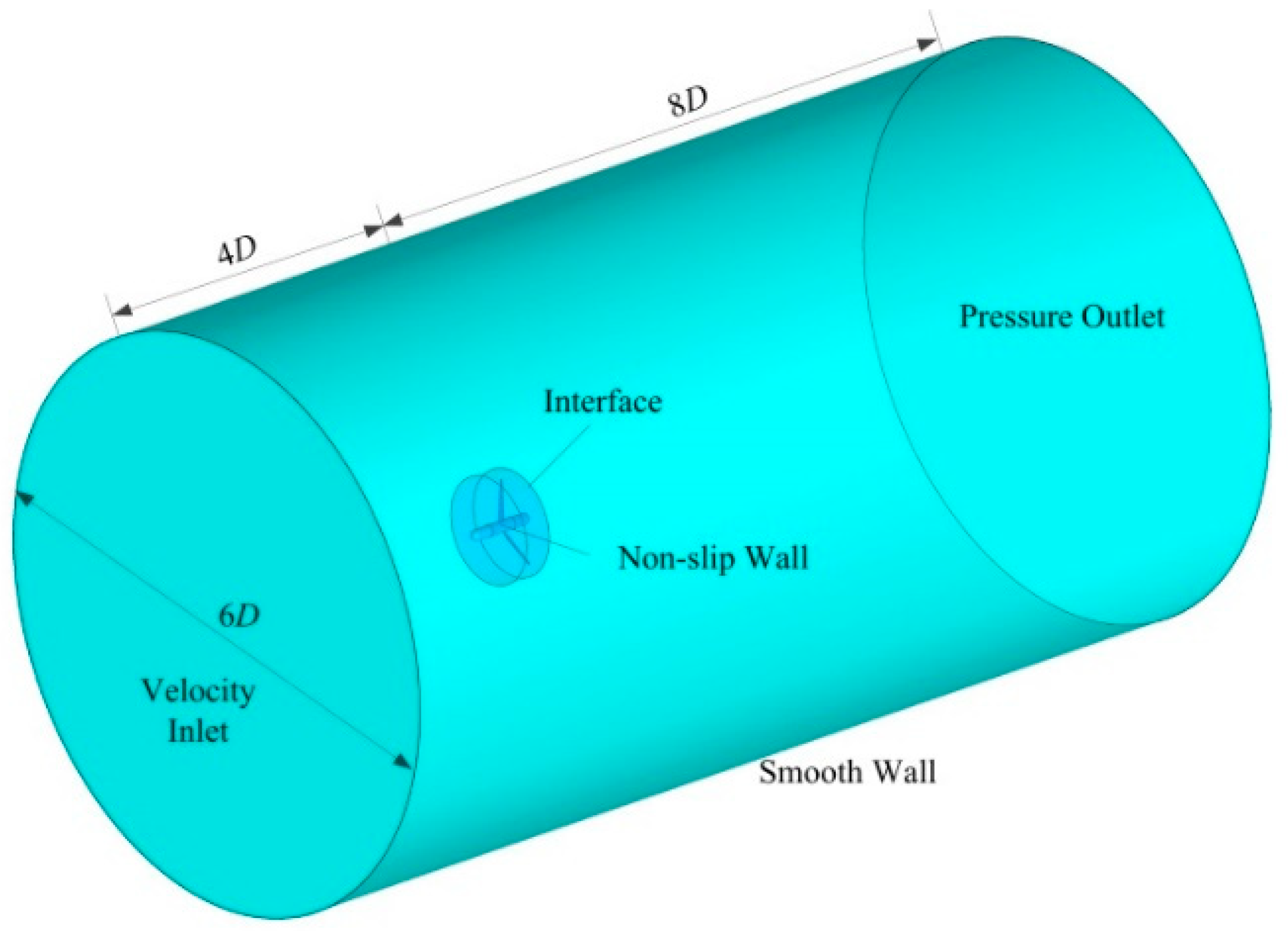

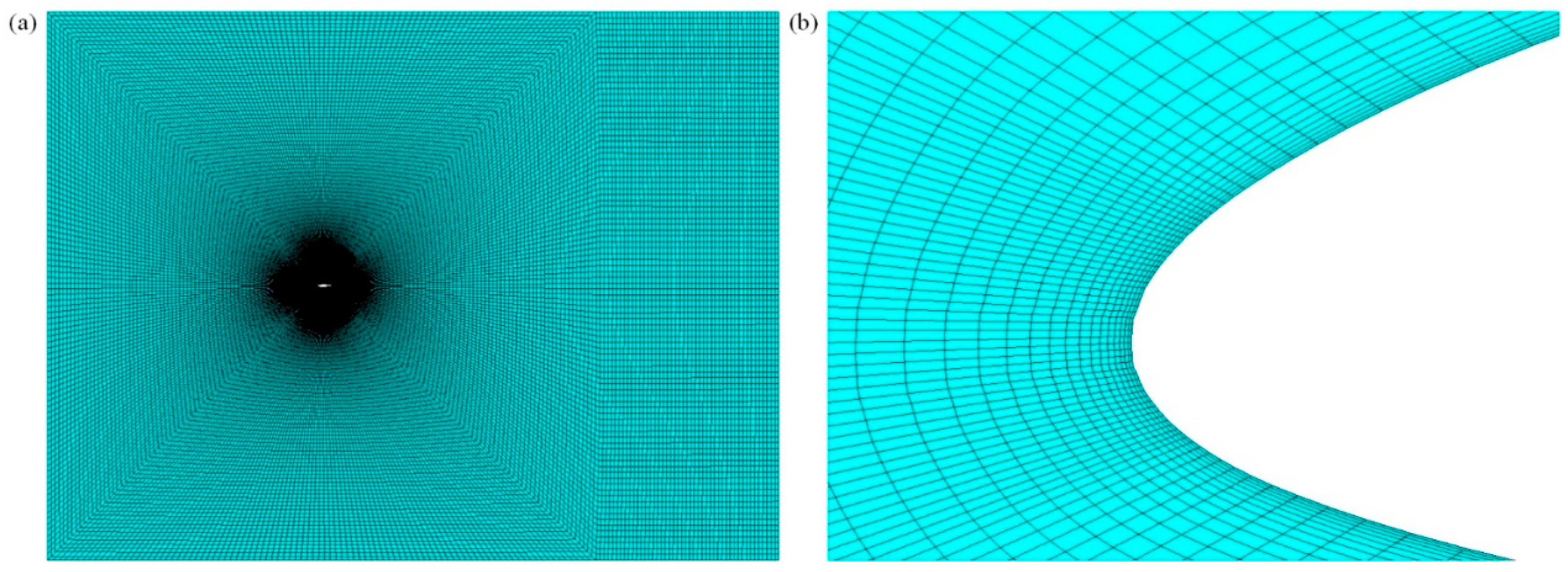


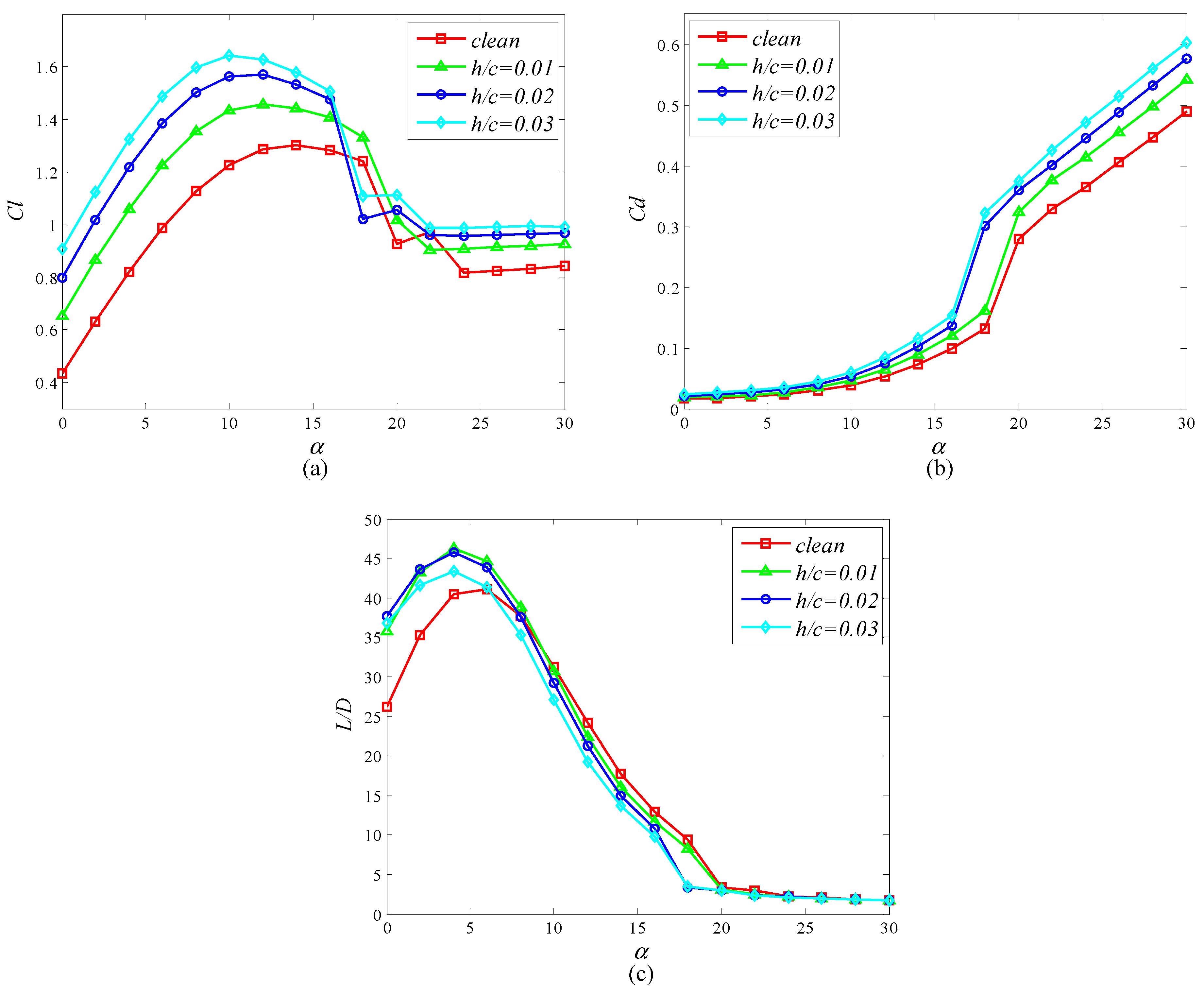

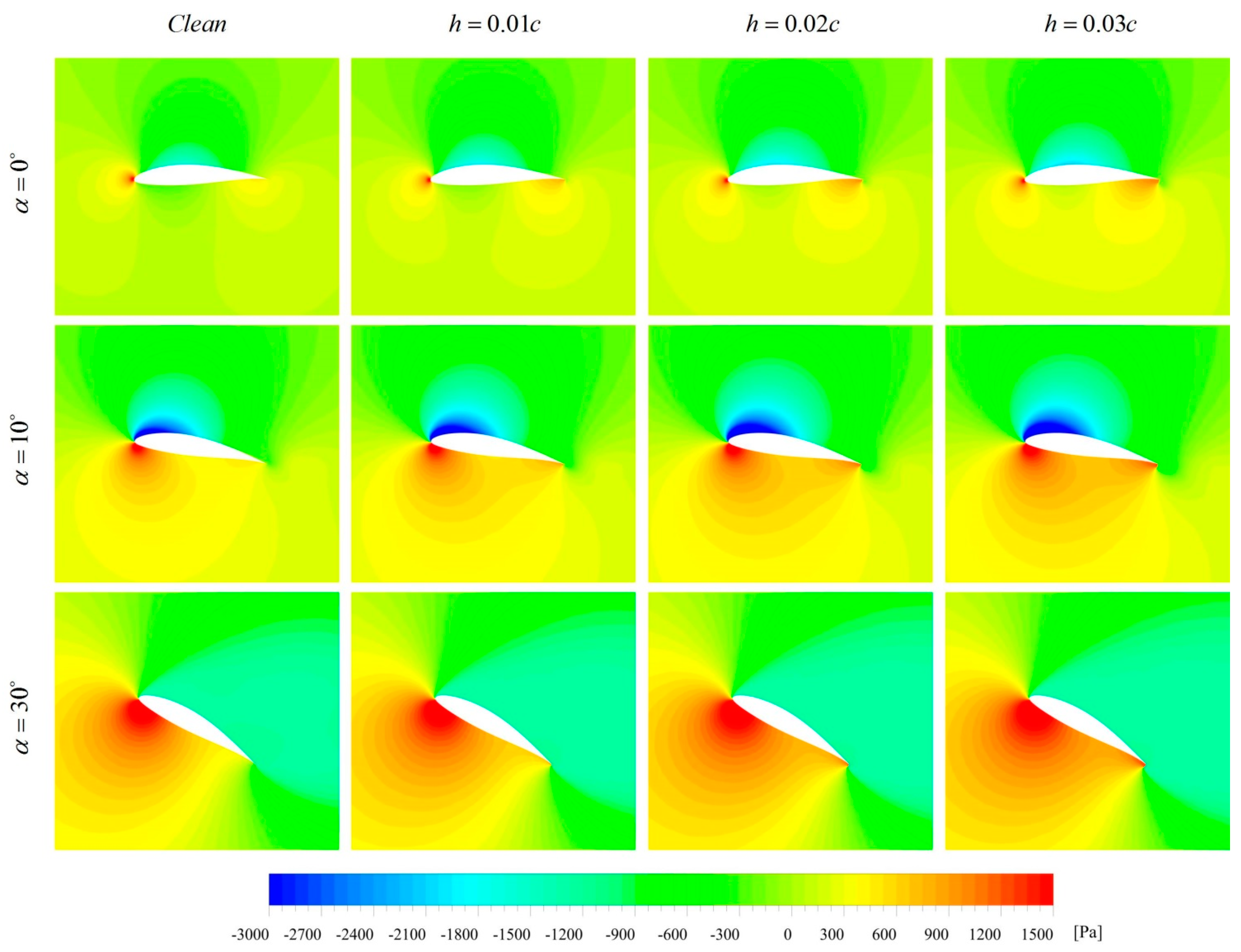
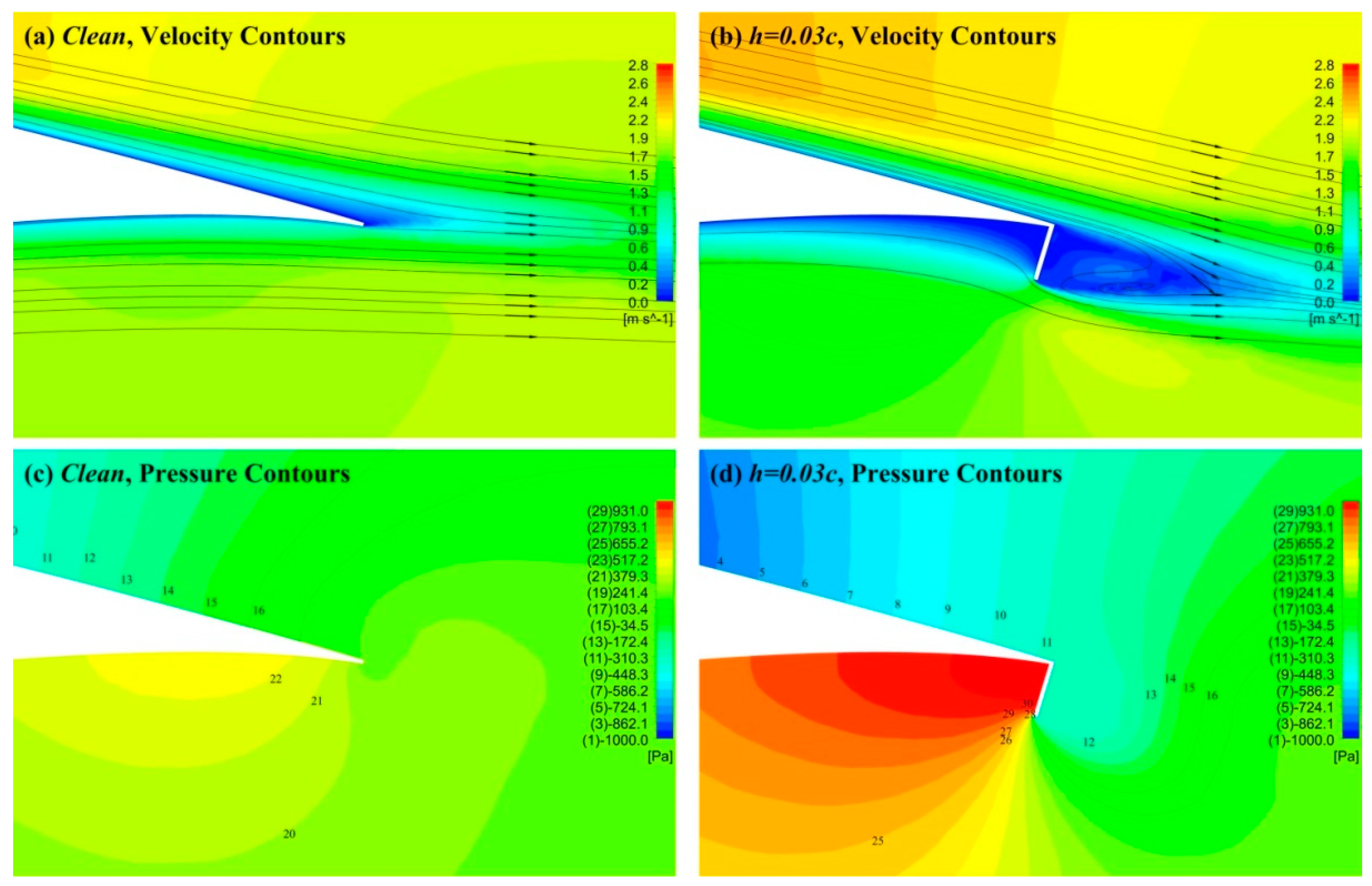

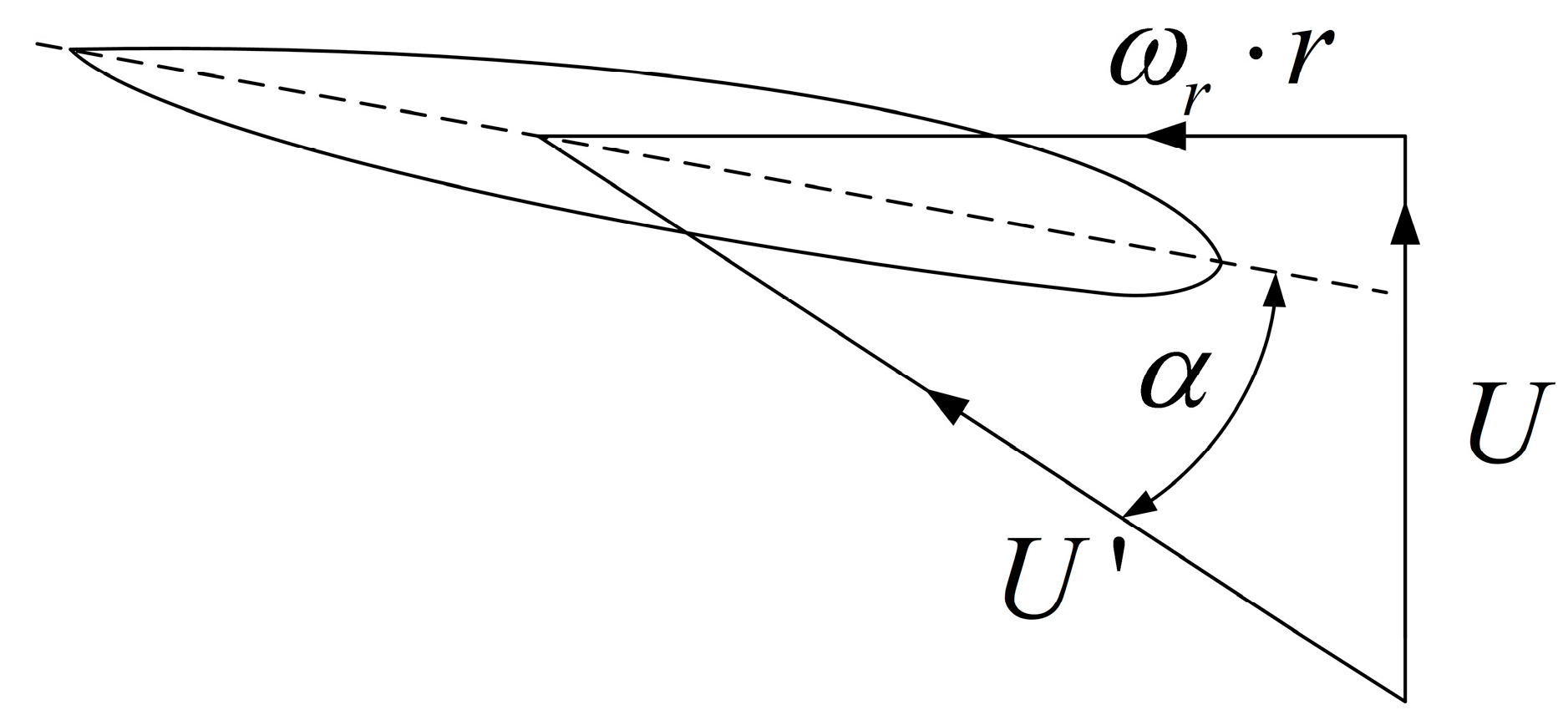
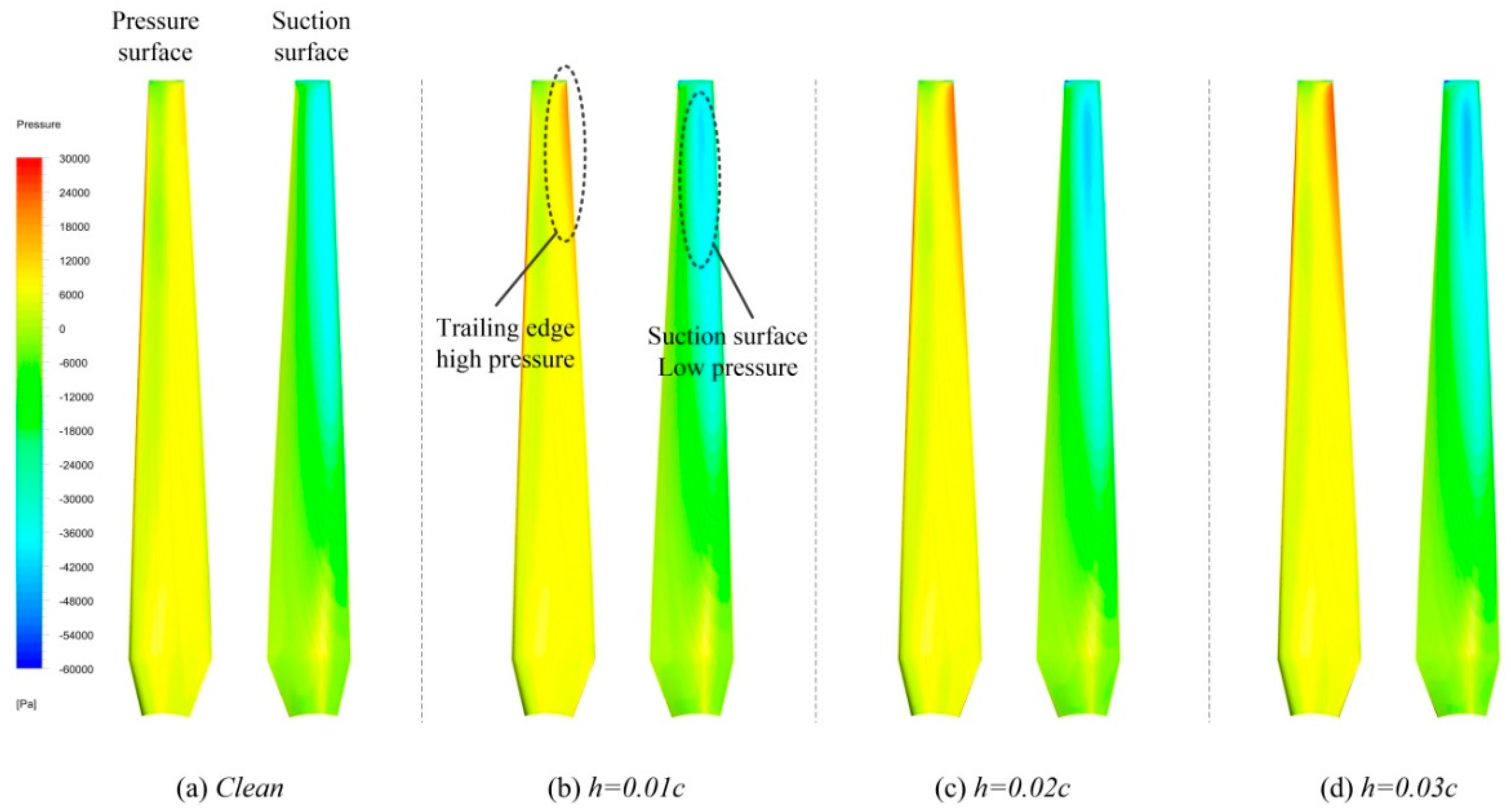
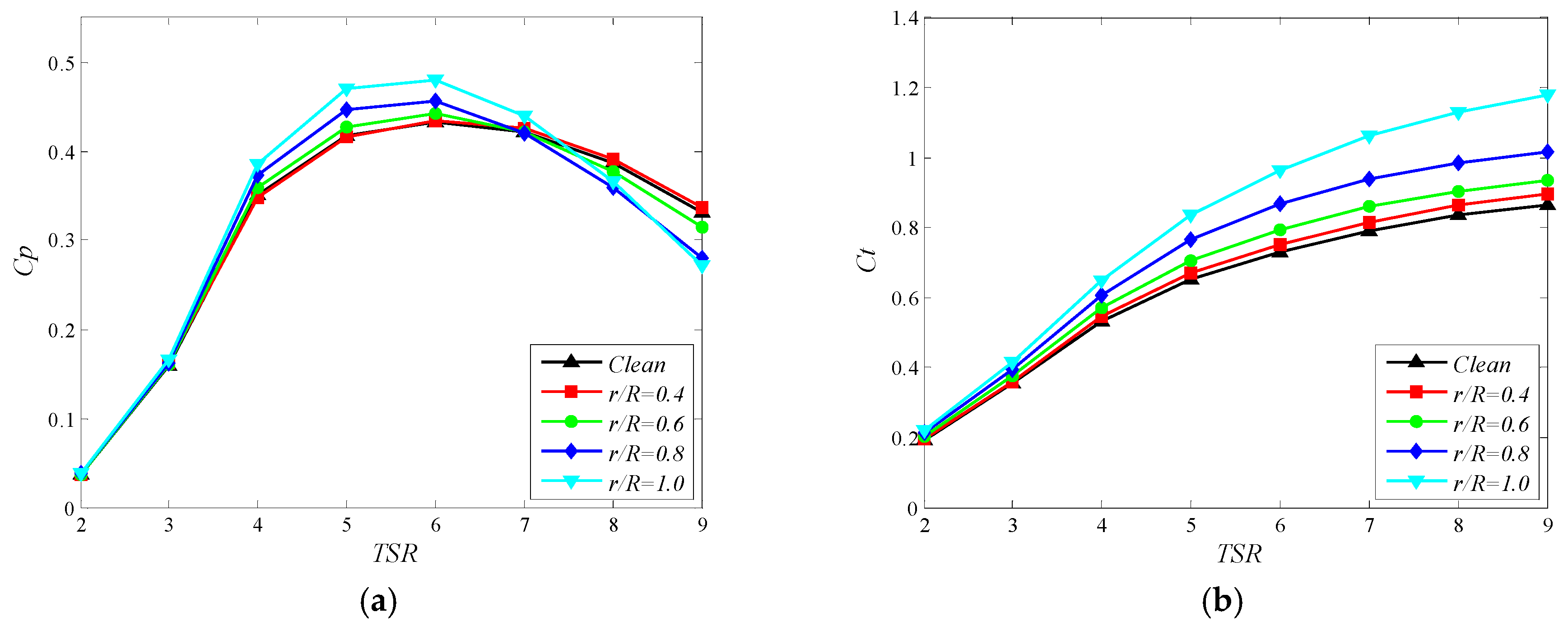


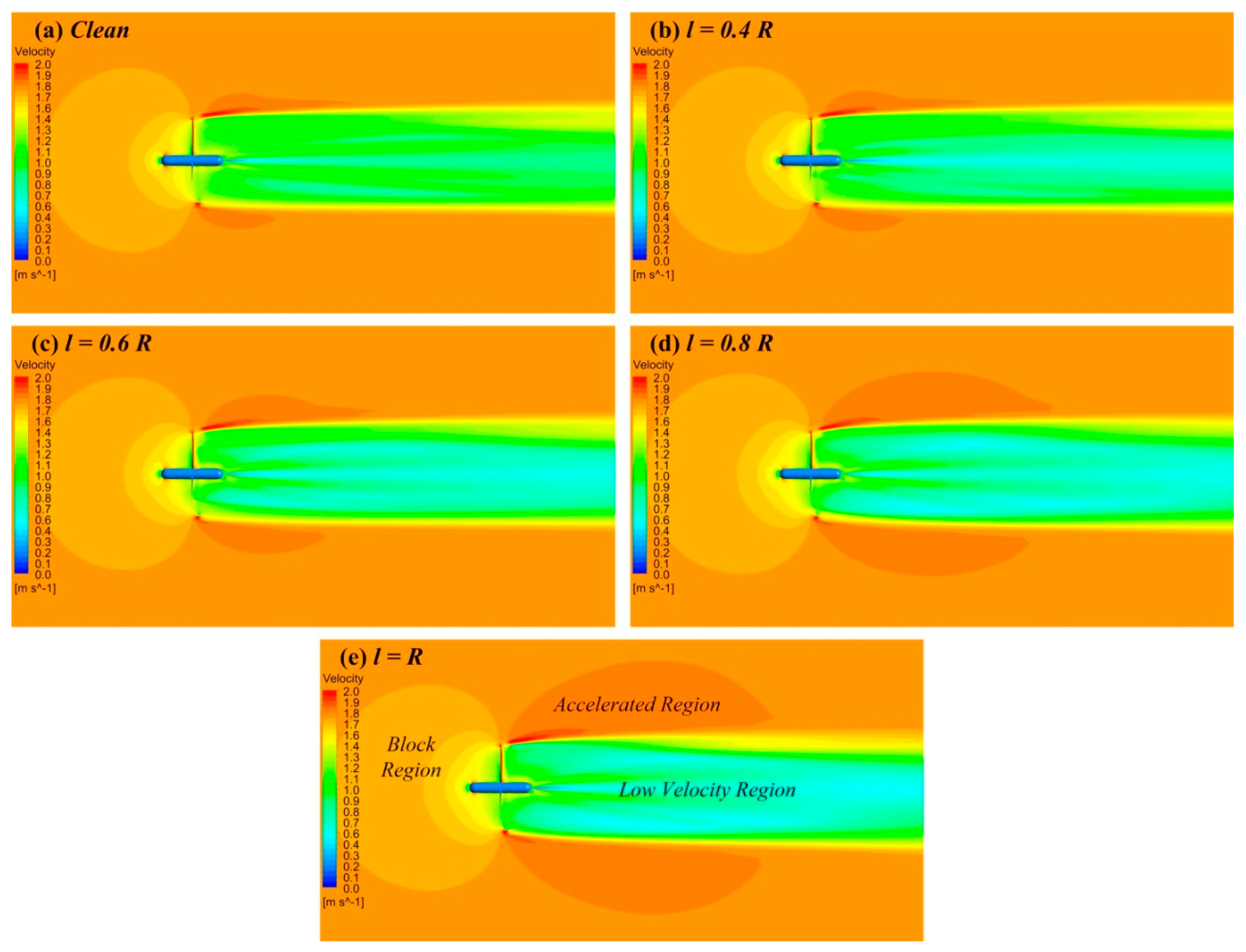
| Number of blades | 3 |
| Rotor diameter [m] | 0.8 |
| Hub radius [m] | 0.05 |
| Hub length [m] | 0.6 |
| Rotor radius [m] | 0.4 |
| Flap length [m] | 0, 0.4 R, 0.6 R, 0.8 R, R |
| Flap height [m] | 0, 0.01 c, 0.02 c, 0.03 c |
| Free-stream velocity [m/s] | 1.73 |
| Turbulence intensity [%] | 2 |
| Rotational speed [rad/s] | 8.65~38.925 |
| Tip speed ratio | 2~9 |
Disclaimer/Publisher’s Note: The statements, opinions and data contained in all publications are solely those of the individual author(s) and contributor(s) and not of MDPI and/or the editor(s). MDPI and/or the editor(s) disclaim responsibility for any injury to people or property resulting from any ideas, methods, instructions or products referred to in the content. |
© 2023 by the authors. Licensee MDPI, Basel, Switzerland. This article is an open access article distributed under the terms and conditions of the Creative Commons Attribution (CC BY) license (https://creativecommons.org/licenses/by/4.0/).
Share and Cite
Mao, Z.; Zhang, T.; Yang, G.; Tian, W. Effects of Gurney Flaps on the Performance of a Horizontal Axis Ocean Current Turbine. J. Mar. Sci. Eng. 2023, 11, 2188. https://doi.org/10.3390/jmse11112188
Mao Z, Zhang T, Yang G, Tian W. Effects of Gurney Flaps on the Performance of a Horizontal Axis Ocean Current Turbine. Journal of Marine Science and Engineering. 2023; 11(11):2188. https://doi.org/10.3390/jmse11112188
Chicago/Turabian StyleMao, Zhaoyong, Tianqi Zhang, Guangyong Yang, and Wenlong Tian. 2023. "Effects of Gurney Flaps on the Performance of a Horizontal Axis Ocean Current Turbine" Journal of Marine Science and Engineering 11, no. 11: 2188. https://doi.org/10.3390/jmse11112188





